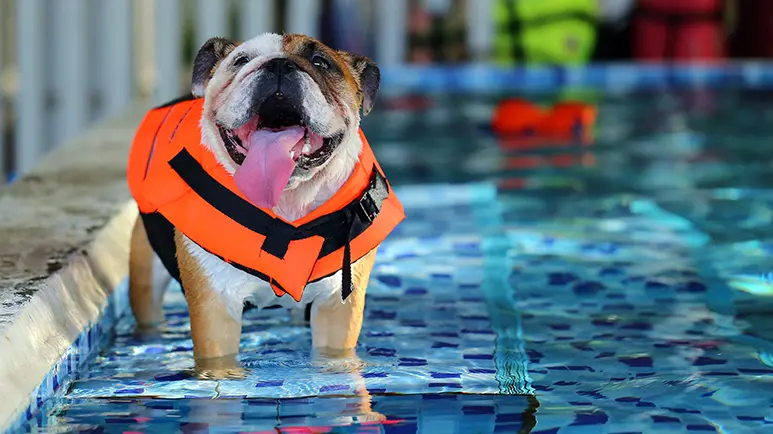Wag More, Splash More! A Paw-Some Guide to Teaching Your Dog to Swim
Think all dogs can swim? Think again. Here is a handy guide to help you safely turn your pup into a confident swimmer this summer.

STORY AT-A-GLANCE
- Not all dogs are born swimmers — Some breeds are built for the water, but others need help. With patience, most pups can learn to enjoy swimming safely and confidently
- Whether near a pool, lake, or beach, teaching your dog how to paddle and find an exit could save their life in an emergency
- Swimming is a gentle, full-body workout that builds muscle, boosts heart health, and eases joint pain — perfect for dogs of all ages, especially seniors
- A well-fitted dog life jacket boosts confidence and prevents panic. Don't forget other must-haves like fresh drinking water, sunscreen, and floating toys
- Begin in shallow, calm water. Let your dog explore, offer support, and use toys, praise, and short sessions to build a positive experience
When summer heats up, there is no better way to cool down and have fun than a good splash in the water. And guess what? Your dog might think so too — if you teach them how!
Whether you are heading to a lake, planning a beach day, or just hanging out by the backyard pool, knowing how to swim can be a lifesaver for your pup and a joy-filled activity for both of you. But contrary to the old myth, not all dogs just "know" how to swim. Like you, your dog needs to learn, practice, and build confidence in the water.
Not All Dogs Are Natural Swimmers
Some dog breeds were born for water. Labrador Retrievers, Portuguese Water Dogs, or Newfoundlands are examples of breeds that do well during pool time, due to their webbed paws, thick, water-repellent coats, and strong, sturdy bodies built for swimming.1
On the flip side, breeds like Bulldogs, Dachshunds, Pugs, and Basset Hounds may struggle due to their body shape, short snouts, or small legs.2 Even if your dog is one of these less buoyant types, though, that does not mean swimming is off the table. With the right support and patience, almost any dog can learn to enjoy the water safely.
Knowing How to Swim Can Be a Life-Saving Skill
Just like kids, dogs need water safety skills. Even if your dog is not a fan of swimming, knowing how to paddle and exit the water can be lifesaving. Whether you live near a lake, visit the beach, or have a backyard pool, accidents can happen. Dogs can fall into the water by mistake or wander too far chasing a toy or another dog. If they do not know how to stay afloat and find an exit, the results can be heartbreaking.
This is why basic swimming lessons and pool training are essential — even if swimming does not become your dog's favorite hobby.
Swimming Has Health and Emotional Benefits Too
Swimming is a low-impact, full-body workout for dogs. It strengthens muscles, improves heart health, and burns off energy without stressing joints. That makes it an ideal exercise for senior dogs or pups with arthritis and mobility issues.3
Beyond the physical perks, swimming can help build trust and deepen your bond with your dog. When you introduce them to the water gently and positively, you are creating a fun and safe experience that they will associate with being close to you.
Preparing the Right Gear Is Important
Before your pup takes the plunge, make sure you are set up for success with the right swimming gear. One of the first things they need to have is a life jacket, regardless of your dog's breed or swimming ability. A life jacket keeps your pup afloat, builds confidence, and provides extra safety — especially in unpredictable situations like waves, deep lakes, or boating adventures.
According to Michele Godlevski, a Certified Professional Dog Trainer and Certified Canine Behavior Consultant:
"Buy a doggie life vest that fits your dog comfortably. No matter what breed you have, you always want that first experience to be fun, and not scary."4
To find the ideal life jacket that fits your dog, remember to look for one that:5
- Fits snugly and adjusts easily
- Has a handle on top (for easy lifting)
- Is made of bright or reflective material for better visibility
- Offers good belly support and possibly extra chin support for low-snouted dogs
Other essentials you need to have include leash and harness (make sure to use these at public swimming spots), floating toys for motivation, dog-safe sunscreen for very hot days, towels, a rubber mat, and a first-aid kit. Godlevski also recommends bringing a life vest for yourself, so that in case your dog panics and starts climbing on you, you will stay afloat.
You should also bring fresh drinking water and a bowl. Do not let your dog drink from the pool, ocean, or lake.
Teaching Your Dog to Swim, Step-by-Step
Once you've got the right gear, it's time to pick the right spot. While there are many places to choose from, Godlevski recommends a place where there's a gradual slope in the water. She also recommends checking the weather and water temperature. Make sure the combined air and water temperature is at least 100°F. Cold water can lead to hypothermia or "swimmer's tail," (also known as "limber tail") a painful condition that causes the tail to droop limply.
Be sure to avoid swimming in water that looks green, blue-green, brown, or murky. Toxic algae blooms, especially in lakes and ponds, can make your dog very sick — or worse. Always check local advisories if you are unsure. Once you have these factors in check, follow these steps:6,7
- Start in a calm, shallow area — A quiet lake or dog-friendly pool with a gentle slope will suffice. Avoid the ocean or fast-moving rivers for your dog's first swim. Waves and currents can be scary and dangerous for beginners.
- Put your dog in their life jacket before they even approach the water — Make sure it fits properly and let your pup walk around in it to get used to the feeling of wearing it.
- Let your dog explore — Never toss your dog into the water. Let them dip their paws in and walk along the edge until they are comfortable. Use encouraging words, treats, and toys to help them associate water with fun, not fear. If they seem unsure, wade in with them. Show them it is safe by staying calm and positive.
- Offer gentle support — As your dog moves into deeper water, place your arm gently under their belly. This helps them stay level and encourages them to use all four legs — not just the front ones — to paddle. Without this help, dogs often do "front-wheel drive" swimming, which quickly tires them out.
- Keep sessions short and sweet — Limit swim time to 10 minutes or less, especially during their first few times. Dogs can get tired quickly in the water, and overdoing it can lead to water toxicity (more on this in a moment) or stress. Finish each session with lots of praise, a rinse-off to remove chlorine, sand, or lake grime, and maybe a treat or two for a job well done.
- If you have a friend whose dog already loves the water, try arranging a swim date — Watching another pup dive in with confidence can help your dog feel more comfortable and curious.
If you have a senior dog, do not be afraid to let them try swimming as well. It is a gentle way to stay active; it can help soothe aching joints and keep your pet in shape, both physically and mentally. Be sure to check with your veterinarian first to be sure it is safe.
It is important to not let your dog swim unsupervised. Hazards like wildlife, hidden drop-offs, or discarded fishing gear can turn a fun outing into an emergency in seconds.
Also, remember that, dogs swallow water when they swim. While this is normal, too much can lead to water toxicity and can have dangerous complications. If your dog vomits after swimming or seems bloated or weak, call your veterinarian right away.
Make sure your dog always knows how to get out of the water, especially in pools. Practice walking in and out, or swimming toward an exit ramp or shallow shore. This step can save your pet's life if they accidentally fall in when no one is watching.
If Your Dog Does Not Like Swimming, Don't Force It
Some dogs just are not into getting wet and that is OK. Do not force your pet to do something they are not comfortable or happy doing. Instead, let your dog cool down safely by:
- Providing a shallow kiddie pool with a non-slip mat on the bottom for them to play in
- Using a sprinkler in the yard for splash time
- Letting them wear a cooling vest for hot summer days
- Going for walks near the water without going in
Teaching Your Dog to Swim Is a Gift That Lasts a Lifetime
Don't let your furry pal feel left out this summer! Teach them to swim — it boosts their confidence, strengthens your bond, and could save their life one day. Like any skill, it takes patience, practice, and lots of encouragement.
This summer, pack the towels, grab the treats, and get ready to wag more and splash more. Your dog's next adventure starts with a single paw in the water.










